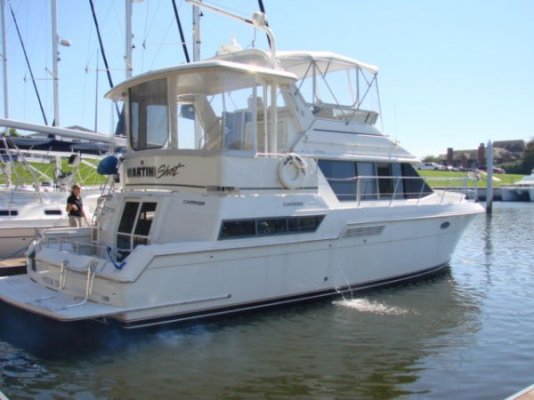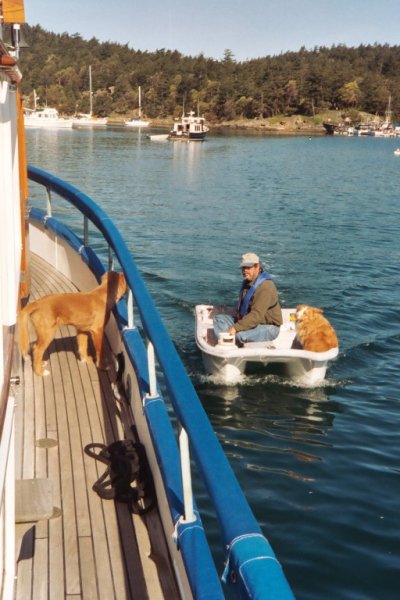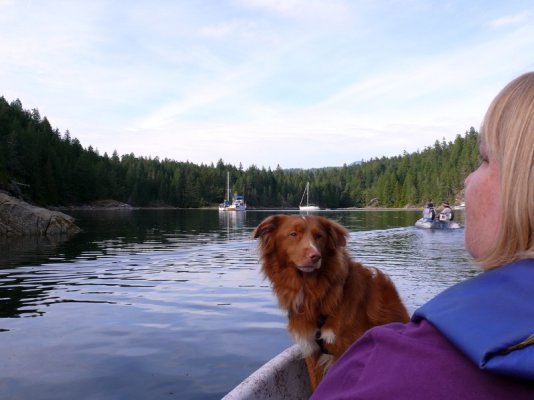timjet
Guru
- Joined
- Apr 9, 2009
- Messages
- 1,920
Hi Folks,
I think I've finally sold my sailboat, I'll know Friday, and will be on the lookout for a trawler/motor cruiser. I've been looking a bit and like the sundecks because of the aft stateroom, large outdoor area above the aft stateroom (sundeck), and the ease in which to get from the flybridge to the sundeck and then to the salon interior area. No ladders to climb like so many sedans. But there is a problem with the sundeck design, the admiral doesn't like it because of the high transom which makes it difficult to get aboard from a dingy. Especially with a large dog. Get rid of the dog you say? Don't even go there!
Does anyone have a solution to this problem. Those who have large dogs know what I'm talking about especially those that are on the hook a lot as we intend to be.
One possible solution is to go with a trunk cabin, but I haven't found any for < $70,000, '86 and later, NO TEAK, and 35+ ft. Plus I really don't like the look of a trunk cabin. And surprisingly most of the mid 80's trunk cabins don't have a transom door.
A compromise boat that I was told to look at on this forum is the 38 Bayliner. It's a sedan with the ladder to the fly bridge but a lot, lot, boat for the money. After some research I feel that the quality issues that have plaged bayliners do not neccessarily apply to the 38. It was built along with the 32 in a different factory under different specs. At least that's what I've been told. Most 38 Bayline owners on the Bayliners Owner Forum consider their boat a value boat and most are very happy to have so much for so little.
So 2 questions:
How can I make the admiral happy with a sundeck, and
Opinions on the Bayliner 38 please.
Thanks,
Tim
I think I've finally sold my sailboat, I'll know Friday, and will be on the lookout for a trawler/motor cruiser. I've been looking a bit and like the sundecks because of the aft stateroom, large outdoor area above the aft stateroom (sundeck), and the ease in which to get from the flybridge to the sundeck and then to the salon interior area. No ladders to climb like so many sedans. But there is a problem with the sundeck design, the admiral doesn't like it because of the high transom which makes it difficult to get aboard from a dingy. Especially with a large dog. Get rid of the dog you say? Don't even go there!
Does anyone have a solution to this problem. Those who have large dogs know what I'm talking about especially those that are on the hook a lot as we intend to be.
One possible solution is to go with a trunk cabin, but I haven't found any for < $70,000, '86 and later, NO TEAK, and 35+ ft. Plus I really don't like the look of a trunk cabin. And surprisingly most of the mid 80's trunk cabins don't have a transom door.
A compromise boat that I was told to look at on this forum is the 38 Bayliner. It's a sedan with the ladder to the fly bridge but a lot, lot, boat for the money. After some research I feel that the quality issues that have plaged bayliners do not neccessarily apply to the 38. It was built along with the 32 in a different factory under different specs. At least that's what I've been told. Most 38 Bayline owners on the Bayliners Owner Forum consider their boat a value boat and most are very happy to have so much for so little.
So 2 questions:
How can I make the admiral happy with a sundeck, and
Opinions on the Bayliner 38 please.
Thanks,
Tim







